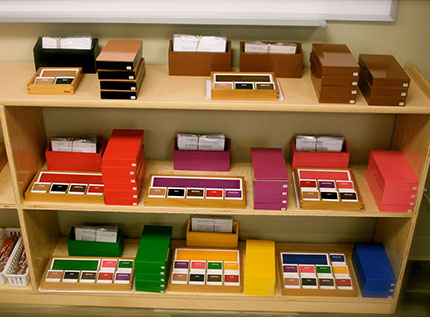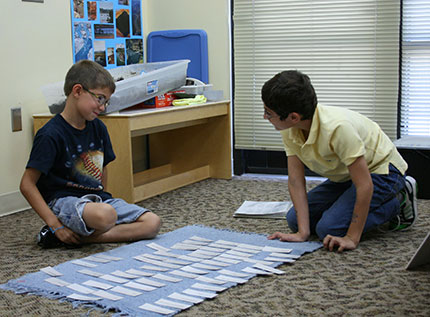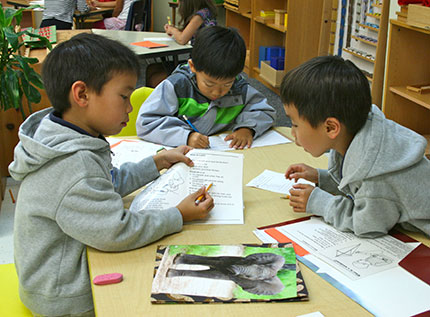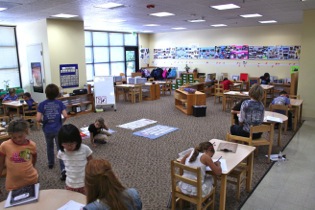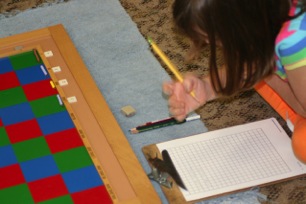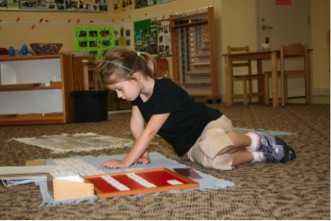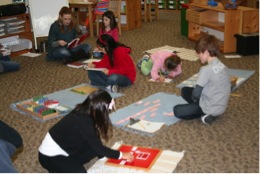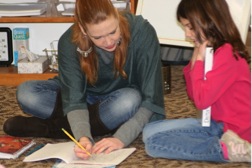Teaching Math Conceptually
For many people, children and adults alike, mathematics is a bane to be avoided. “Math anxiety” or even “math phobia” is on the rise in elementary and high schools across the country, and perhaps as a consequence, U.S. students notoriously score very low among developed nations on international math tests.
And yet, mathematics is not an optional activity. Handling numbers is a fundamental and necessary life skill, and a prerequisite for many careers, including those in engineering, the sciences and business.
So in relation to your own child’s education, what can and should you do about the distressed state of modern mathematics? The best thing you can do is to find a math program that works. If you want your child to be comfortable with numbers, and thrive in mathematics, you need to find him or her a curriculum capable of achieving these results.
At LePort, we believe that our approach, from preschool through 8th grade, enables students to not only master crucial math skills and concepts, but to develop into young people who are confident in their ability to tackle even the most challenging mathematical problems.
In this newsletter, we give you three highlights of our math approach. For a fuller description of our math programs, please visit the elementary school page.
The “secret” of our approach is teaching math conceptually, first starting with a sequential, targeted introduction to concrete manipulatives, then enabling mastery through deliberate, focused, motivated practice, and then allowing the experience of efficacy through the application of skills in increasingly complex, real-life problems. How does this work? And how is it different from the approaches used in other schools?
In this newsletter, I’d like to share with you three important aspects of our approach:
- We develop real understanding by using carefully structured manipulatives, and, more generally, by always progressing from concrete to abstract in a deliberate sequence.
- We enable each child to attain mastery of math facts, at his or own pace,before we expect him or her to apply those skills to more complex problems.
- Once a skill is learned, we explicitly teach mathematical problem solving, and advance, rapidly, to applying the skills learned to complex, real-life, meaningful math problems.
For each of these three principles, we’ll provide an example from our program, and compare it to the program used by the Irvine Unified School District (“Math Expressions”, by Houghton Mifflin publishers.) We’ll conclude by summarizing the value our students gain from this program: an advanced conceptual knowledge of mathematics, an earned confidence in their ability to handle mathematical problems, and enjoyment, rather than dread, of math class.
- Building understanding using carefully structured manipulatives, with a deliberate progression from concrete materials to abstract operations. Math is the science of quantitative measurement. It enables us to deal with quantities in all aspects of our lives. At LePort, our goal is to enable our students to really get the connection between real quantities on the one hand, and mathematical symbols and processes on the other.For example, consider the topic of place value and multi-digit addition. In our preschool classes, students learn place value into the thousands, using a material that concretely demonstrates this concept. This Golden Bead material includes individual beads or single “units,” strings of ten beads or “ten bars,” ten ten-bars combined into a “hundred square,” and ten hundred squares combined into a “thousand cube.” Number cards go along with these beads, with units printed in green, tens in blue, hundreds in red, and thousands in green.Using these cards and beads, 4 ½ and 5-year-old children build large numbers. For instance, a teacher may create a number with the cards, such as 3,574, and ask the child to bring her the corresponding number of beads: 4 Units, 7 Ten Bars, 5 Hundred Squares and 3 Thousand Cubes. After repeated exercises of this kind, students never confuse “1,006” with “1,060” or “1,600.” They clearly understand what each number stands for, and that a “zero” stands for no number in that category, i.e., no tens or no hundreds!With this specially-designed material, our students go on to explore addition and subtraction into the thousands, by Kindergarten. They simply “make” two large numbers with the bead materials, and combine them, exchanging units for tens, tens for hundreds and so on. For example, when they add 3,574 and 4,267, they first take the 4 units and the 7 units, and count them up, to get 11 units. They exchange 10 of those units for a ten bar, leaving them with one unit. Next, they add the 7 ten-bars, 6 ten-bars, and the “carried” ten-bar, to get 14 ten-bars. They exchange 10 ten bars for a hundred square, leaving them with 4 ten bars.Thus, “carrying” (and, later, “borrowing”) are more than mere abstract process steps to be memorized. In our students’ minds, these operations are real, forever tied to the Golden Beads they learned them with.
In contrast, local public school systems introduce 3-digit addition in 2nd grade, using a purely “paper-and-pencil” approach, representing units, tens and hundreds with drawn circles, lines and squares, rather than actual quantities.
The Irvine School District’s Math Expressions program encourages “children [to] do this with methods they invent themselves, or they [can] extend the drawings they did for 2-digit addition.” Then, students are introduced to different methods, such as “New Groups Below” and “Show All Totals,” and then encouraged to use “use any method they understand, can explain and do fairly quickly.” (Quoted from the family letter on Unit 6, 2nd grade Student Activity Book Volume 2 of the Math Expressions Program, which you can find here. You can also read about this paper-and-pencil approach to representing place value on Houghton Mifflin’s web site.)
The problem with this method is that it expects students to learn about place value purely abstractly, with paper and pencil, without the benefit of experiencing the actual quantities that are represented by the symbols the students learn. Some children are, by second grade, able to learn this abstract progression, but many others understandably struggle. Also observe that by teaching this potentially concrete mathematical lesson in such an abstract way, the public schools are forced unnecessarily to delay this more abstract material to the higher grades, rather than teaching at a younger, more developmentally appropriate age.
In contrast, our students readily learn the mechanics of multi-digit addition and subtraction in Kindergarten–which leaves them free to advance to multi-digit multiplication by 2nd grade. (Such multiplication lessons are learned through a series of unique materials that you can read about here.)
- Progressing at an individual pace, students achieve mastery of math facts before using those facts to solve advanced math problems. Whether in preschool or in middle school, our math program enables students to progress at their own pace, and to master what they learn before they move on to the next step. Take, for example, our elementary math program. With 24 students in her class of 6 to 9-year-olds, our teacher may give 10 or more distinct math lessons in any given week. Because Montessori consists primarily of small-group instruction, she may sit down with an advanced 7-year-old and two 8-year-olds to work on multi-digit long multiplication. She may introduce the process using a material such as the “Large Bead Frame” or “Checker Board” (see our web site, as linked to above, for more detail on these materials.)Once the students get the idea, they each go off to practice on their own for however long it takes them to master this new concept. (The teacher and/or assistant teacher are available to offer reinforcement, support, and oversight as necessary.) One student may get really intrigued, and spend several hours practicing with a given material, each day, for many days, until she has fully internalized how long multiplication works; another student may spread her work out over several weeks, revisiting the same concept and reinforcing it more deeply every time. Each child progresses at his own pace, practicing until he achieves mastery, and only then moving on. Notice also that an advanced first grader may work with second graders or third graders: in this respect, there is no leveling to the common denominator in our classrooms!The contrast to public education couldn’t be more pronounced. However dedicated a public school teacher may be to meeting the needs of her different students, by necessity she follows a one-size-fits-all approach.Here, for instance, is the introductory text, printed in red, bold, and underlined, on the Irvine Unified School District web site where the Math Expression student materials for grades K-5 are located:The links on this page are intended to support the classroom instruction that your child receives from his/her teacher. It is not appropriate to go ahead of the classroom instruction or to use this site to have your child work on math that is intended for use in subsequent grade levels.Your child’s math instruction and placement will not change as a result of working ahead in these materials. This means that your child will continue to work in the grade level appropriate math materials regardless of any work that is done from these materials and submitted to his/her teacher.
The school district is understandably trying to ensure that parents conform to their system. The problem is not that they are doing so, given their system, the problem is the system itself. In this type of program, no matter how skilled (or challenged) your child may be in math, he must work on exactly the same problems as his classmates. Unfortunately, this means that children who complete a Montessori Kindergarten program, and have already mastered addition and subtraction into the thousands, will have to bide their time until 3rd grade, to again encounter such challenging work. By that time, their interest and excitement for math may have long atrophied and turned to boredom.
- Explicit instruction in problem-solving skills, which means the application of already-mastered computational skills to solve complex, real-life problems. Once our students have become familiar with basic operations and have automatized their math facts, we help them acquire a conceptual approach to math problems. For instance, we teach them how to diagram a word problem question. We start with problems with easy computations, and then, very quickly, move on to more sophisticated questions.As an example, our 3rd grade students, who have already mastered basic multiplication facts, may get this question from our Singapore Math workbook for 3rd grade:
Singapore math, 3rd grade: A farmer has seven ducks. He has five times as many chickens as ducks. How many chickens does he have?We teach the student to represent this problem graphically, by drawing a box representing the seven ducks, and underneath it drawing a line of five equivalent boxes representing the chickens. Through this method, the student sees that there are 35 chickens.More importantly, the student learns a method of visually representing such a problem–a method that he may not even need for this question but that he will later apply to solve much more complex problems. For example, by 5th grade, they may encounter this problem:
Singapore math, 5th grade: Sam had $85 and John had $220. They were each given an equal amount of money, and then John had twice as much money as Sam. How much money did each boy receive?This problem requires students to solve an equation with one unknown, in this case,
2*(85+x) = 220 + x.Not having learned algebra yet, a student cannot just “intuit” the answer. He needs to diagram the problem, and then solve it, a process he has been taught and has practiced since his lower elementary years, and with which he is quite comfortable by the time he encounters such a question.
It is important to note that when teaching problem solving skills, we start with simple computations first, because the focus is on teaching the method of diagramming problems, which the students can then apply generally. Students are expected to be able to multiply 7×5, for example, long before they are given the 3rd grade problem. The reason for involving a computation they have mastered is that it allows the child to isolate the problem solving skill being presented.
In contrast, the Math Expressions program used in the Irvine public schools does not distinguish between teaching the computational facts, and teaching a problem solving approach involving the use of those facts. The program does try to push a conceptual perspective, for example by emphasizing diagrams and word problems. But it does so at the same time as teaching the basic facts. As a result, the word problems have to be very simple, which in turn means they don’t actually promote a conceptual approach. Instead, they risk teaching students to mechanistically apply memorized processes to solving math problems, leaving students stumped when they are expected to deal with more complex problems in the higher grades.
Compare the Singapore Math 3rd grade problem, above, with this problem, from the IUSD’s Math Expressions in 3rd grade:
Math Expressions, 3rd grade: The Fuzzy Friends pet store has 3 rabbit cages. There are 5 rabbits in each cage. How many rabbits does the store have in all?
This problem, in essence, is the equation 3×5, with some words thrown in. The purpose here is unclear–is it to teach the computation 3×5, or to teach problem solving involving that computation? If the former, then the story problem does not add much of value; if the latter, then the problem is too simple to be effective. (In fact, it is probably the former.)
Because multiplication is introduced to students so late, and with such simplified applications, public school students are essentially two full grade levels behind students participating in a well-executed Montessori program. Witness this example problem from Math Expressions in 5th grade (Activity Book 1, Unit 1, Lesson 5), which is, structurally, exactly the same problem that our 3rd graders solve:
Math Expressions, 5th grade: There are 3 times as many deer as moose in the forest. If there are 5 moose, how many deer are there?
Math is a challenging subject. But because it is challenging, it is also immensely satisfying to master. Our students, whether they come up through our own Montessori program, or join us from the outside, invariably come to like math, and develop a joyous confidence in their ability to solve quantitative programs. The reason is that we make it a point to ensure that students not only learn the skills they need to learn, but that they experience the pleasure, pride, and efficacy of applying those skills.
The proof that our method works? You probably have seen it in your own children, if they have been with us for any length of time, and can share observations like these:My son, who loves math, gets to advance at his own pace. Last spring, when he was in 2nd grade, at “watch me work” day, he was using the Montessori Checkerboard to multiply a 4-digit number with a 3-digit number. He was moving all these bead bars around in this complicated operation, and I couldn’t even follow. But he had mastered it: his result matched the control sheet when he turned it around. It was crazy to see how such a complicated operation can be broken down into concrete materials. My son is now in the fall of 3rd grade, and he is multiplying and dividing fractions! He has already done addition, subtraction, multiplication and division for decimals.
Jan S., parent of a 3rd grade student
At her old school, my daughter worked really hard in math, and it just didn’t work. She told her math teacher that math is now one of her favorite subjects–and you have no idea what that means: this came as a total shock to me and her dad, because she used to cry doing math. It’s a total turn-around from what it was before. Two of her least-favorite subjects, math and science, are now her favorites!
Lina S., parent of a 6th grade student
We hope that this blog post helped you gain a better understanding of our math program. We believe that by combining Montessori math and Singapore Math into a thoughtfully-structured, conceptual approach to teaching mathematics from preschool through 8th grade, we have found the preventative medicine for math anxiety. We hope you will see the results in your child’s enjoyment of and confidence in his math abilities.
We know that paying for a private education is a difficult investment to evaluate, especially when the difference to the public school system is not always evident. Whatever the important non-academic considerations you might be weighing, I hope that by seeing exactly what your child can gain in mathematics, and by contrasting LePort’s math curriculum with the public alternative, you will become better able to judge the ways in which the academic difference might add up for your child.











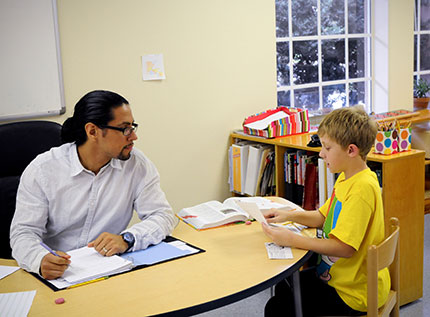 Teachers are guides, not lecturers. They individualize instruction to keep each child optimally challenged. In traditional elementary education, much instruction happens at an all-class level; students generally move through the same curriculum at the same pace. This is more true now then ever, as mandatory standardized testing forces teachers to ensure that all students meet common minimum standards. This approach by definition fails to optimally challenge most of the students, most of the time: a child who is advanced in a subject will be bored; one who is behind will quickly become anxious and concerned about his shortcomings.
Teachers are guides, not lecturers. They individualize instruction to keep each child optimally challenged. In traditional elementary education, much instruction happens at an all-class level; students generally move through the same curriculum at the same pace. This is more true now then ever, as mandatory standardized testing forces teachers to ensure that all students meet common minimum standards. This approach by definition fails to optimally challenge most of the students, most of the time: a child who is advanced in a subject will be bored; one who is behind will quickly become anxious and concerned about his shortcomings. 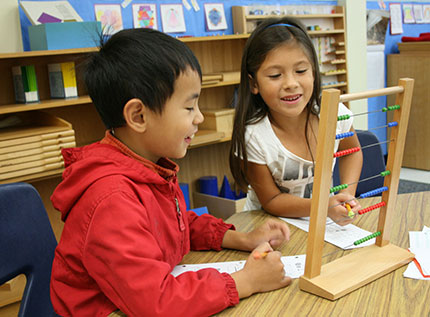 Children have choices, there’s no one-size-fits all curriculum. Students are encouraged to be curious; they are engaged and love learning. When do you do your best work: when someone makes you do a task, or when you freely choose it? Autonomy is a huge factor in motivation, and Montessori elementary enables children to have a say in their learning. Of course, each child has to learn certain skills; mastering arithmetic isn’t optional. But instead of forcing each child to complete the same worksheet,
Children have choices, there’s no one-size-fits all curriculum. Students are encouraged to be curious; they are engaged and love learning. When do you do your best work: when someone makes you do a task, or when you freely choose it? Autonomy is a huge factor in motivation, and Montessori elementary enables children to have a say in their learning. Of course, each child has to learn certain skills; mastering arithmetic isn’t optional. But instead of forcing each child to complete the same worksheet, 